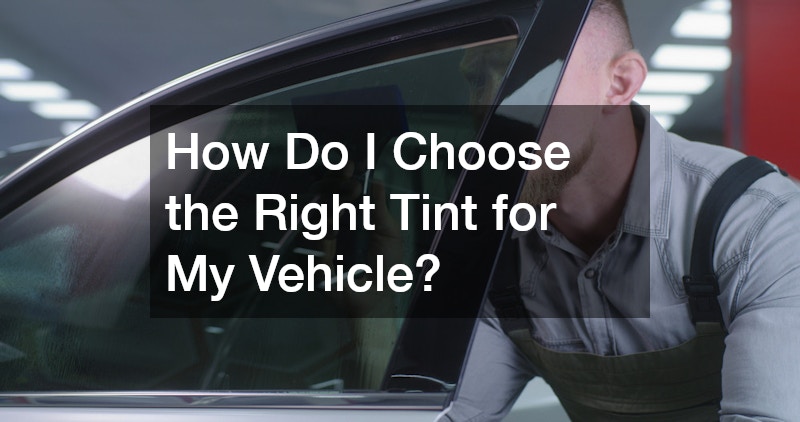Auto window tinting has become a popular upgrade for vehicle owners looking to enhance both the appearance and functionality of their cars. More than just a cosmetic enhancement, window tinting provides practical benefits such as protection from harmful UV rays, heat reduction, increased privacy, and improved safety. Whether you drive a compact car, an SUV, or a luxury vehicle, window tinting can enhance your driving experience while protecting your investment.
Understanding the process, benefits, and legal considerations is essential for anyone considering this upgrade.
How Does Auto Window Tinting Work?
Auto window tinting involves applying a thin, adhesive film to the interior surface of car windows. This film is designed to filter light, reduce glare, and block a significant portion of ultraviolet (UV) rays. The materials used for tinting range from dyed films, which absorb sunlight, to metallic and ceramic films that reflect heat and UV rays.
The application process typically begins with a thorough cleaning of the vehicle’s windows to remove dirt, oils, and debris that could prevent proper adhesion. Next, the tint film is precisely cut to fit each window, often using templates or computer-guided systems for accuracy. The film is then applied using a combination of water or a special solution and a squeegee, allowing the installer to remove air bubbles and ensure a smooth, even surface.
The science behind window tinting lies in its ability to control the passage of light and heat. Tinted films contain layers that absorb or reflect infrared light, which is the primary cause of heat buildup inside a car.
What Are the Benefits of Auto Window Tinting?
Auto window tinting offers a wide range of advantages for vehicle owners. One of the most significant benefits is protection from ultraviolet (UV) rays. Extended exposure to UV radiation can cause skin damage and increase the risk of skin cancer. Tinted windows can block up to 99% of harmful UV rays, providing a safer environment for drivers and passengers.
Heat reduction is another major advantage. Cars parked in direct sunlight can become unbearably hot, putting stress on air conditioning systems and causing discomfort for passengers. High-quality window tinting can significantly reduce interior temperatures, helping to maintain a cooler, more comfortable ride while improving energy efficiency.
Glare reduction is also an important consideration. Excessive sunlight or the reflection of headlights can impair visibility and create dangerous driving conditions. Tinted windows reduce glare, enhancing safety and reducing eye strain.
Privacy and security are additional benefits of window tinting. Darker tints make it more difficult for outsiders to see inside the vehicle, protecting personal belongings from potential theft.
Is Auto Window Tinting Legal in My Area?
Before investing in auto window tinting, it is crucial to understand the legal regulations in your area. Laws governing window tinting vary by country, state, and even city, with restrictions on both the darkness and reflectivity of the film. Common regulations include limits on how dark the front side windows and windshield can be tinted, while rear windows often have more leniency.
It is important to check the specific rules for your jurisdiction before applying tint to your vehicle. Non-compliance with tint laws can result in fines, mandatory removal of the tint, or issues with vehicle inspections. Professional window tinting installers are usually well-versed in local regulations and can help ensure your vehicle meets legal requirements.
How Do I Choose the Right Tint for My Vehicle?
Selecting the right window tint involves several considerations, including the desired level of darkness, the type of tint material, and personal preference. Tint darkness is measured by Visible Light Transmission (VLT), which indicates the percentage of light allowed to pass through the film. Lower VLT percentages result in darker tints, offering more privacy and heat reduction.
There are also different types of window films to consider. Dyed films are cost-effective and provide basic heat and glare reduction. Metallic films reflect heat and add durability, though they may interfere with electronic signals. Ceramic films are premium options that offer excellent heat rejection, UV protection, and signal compatibility without altering visibility.
Personal preference also plays a role in selecting window tint. Some drivers prefer a subtle, barely noticeable tint for a professional look, while others opt for darker shades for maximum privacy and sun protection. Consulting with a professional installer can help you choose a tint that balances aesthetic appeal, comfort, and legal compliance.
Window tinting is more than just a stylish upgrade for your vehicle—it offers tangible benefits such as UV protection, heat reduction, glare control, increased privacy, and added safety. By understanding the application process, advantages, and legal requirements, vehicle owners can make informed decisions about the type of tint that best suits their needs. Whether you prioritize comfort, security, or visual appeal, investing in quality auto window tinting enhances both the driving experience and the longevity of your vehicle.




